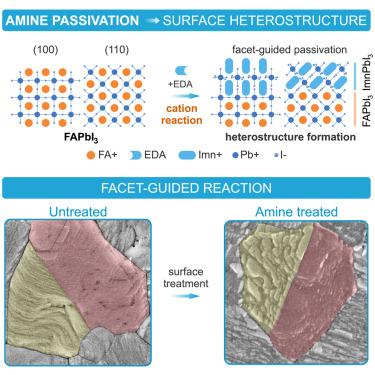The reactive nature of formamidinium: Amine passivation induces heterostructure formation in inverted perovskite cells
IF 35.4
1区 材料科学
Q1 CHEMISTRY, PHYSICAL
引用次数: 0
Abstract
Surface passivation via binding molecules is a strategy for eliminating electronic defects that arise from the abrupt termination of semiconductor lattices. Passivation is used in many systems, such as silanes on silicon surfaces, ligands on nanocrystals, and at interfaces. However, in halide perovskites, such strategies lead to complicated effects, such as the disruption of the crystal structure via molecular intercalation or change of dimensionality. Here, we demonstrate and detail that short diamines undergo a chemical reaction with the existing A-site molecule rather than attaching, forming a ringed molecule and thus, in turn, creating a well-defined and self-limited, lower-dimensional-oriented perovskite-perovskite heterostructure at the surface. Furthermore, we detail how the solvent polarity and the molecule of choice impact the final reaction composition and their effect on device performance. Our findings offer new insights into the perovskite surface chemistry of high-efficiency solar cells.


甲脒的反应性质:胺钝化诱导倒置钙钛矿细胞异质结构的形成
通过结合分子的表面钝化是一种消除由半导体晶格突然终止引起的电子缺陷的策略。钝化用于许多系统,如硅表面的硅烷,纳米晶体上的配体和界面。然而,在卤化物钙钛矿中,这种策略会导致复杂的影响,例如通过分子插层破坏晶体结构或改变维数。在这里,我们证明并详细说明了短二胺与现有的a位分子发生化学反应,而不是附着,形成一个环状分子,从而在表面形成一个定义良好且自我限制的低维取向钙钛矿-钙钛矿异质结构。此外,我们详细介绍了溶剂极性和分子选择如何影响最终反应组成及其对设备性能的影响。我们的发现为高效太阳能电池的钙钛矿表面化学提供了新的见解。
本文章由计算机程序翻译,如有差异,请以英文原文为准。
求助全文
约1分钟内获得全文
求助全文
来源期刊

Joule
Energy-General Energy
CiteScore
53.10
自引率
2.00%
发文量
198
期刊介绍:
Joule is a sister journal to Cell that focuses on research, analysis, and ideas related to sustainable energy. It aims to address the global challenge of the need for more sustainable energy solutions. Joule is a forward-looking journal that bridges disciplines and scales of energy research. It connects researchers and analysts working on scientific, technical, economic, policy, and social challenges related to sustainable energy. The journal covers a wide range of energy research, from fundamental laboratory studies on energy conversion and storage to global-level analysis. Joule aims to highlight and amplify the implications, challenges, and opportunities of novel energy research for different groups in the field.
 求助内容:
求助内容: 应助结果提醒方式:
应助结果提醒方式:


